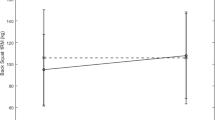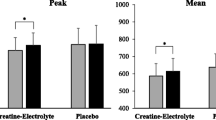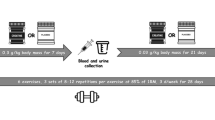Abstract
Creatine is an ergogenic aid used in individual and team sports. The aim of this study is to analyze the effect of monohydrate creatine supplementation on physical performance during 6 consecutive maximal speed 60 meter races, and the changes induced in some characteristic biochemical and ventilatory parameters. The study was carried out on nineteen healthy and physically active male volunteers, and randomly distributed into two groups: Group C received a supplement of creatine monohydrate (20g/day for 5 days) and group P received placebo. Tests were performed before and after supplementation. No significant changes were observed in weight or body water measured by bioimpedance or the sum of 7 skinfold or performance during the 6- meter races. Group C showed a statistically significant increase in plasma creatinine from 69.8±12.4 to 89.3±12.4 μmol·L−1 (p<0.05). In group C in the second control day (after creatine supplementation), expiratory volume VE, O2 uptake and CO2 production were lower after 2 minutes of active recovery period. These results indicate that creatine monohydrate supplementation does not appear to improve the performance in 6 consecutive 60 meter repeated races but may modify ventilatory dynamics during the recovery after maximal effort.
Resumen
La creatina se considera una ayuda ergogénica, siendo utilizada en deportes individuales y de equipo. Se ha analizado el efecto de la ingesta de monohidrato de creatina sobre el rendimiento obtenido en 6 carreras máximas consecutivas de 60 metros y algunos parámetros bioquímicos o ventilatorios. Diecinueve varones sanos, voluntarios, físicamente activos se distribuyeron de manera aleatoria en dos grupos: Grupo C, que recibió un suplemento de monohidrato de creatina (20 g/día durante 5 días) y grupo P, que recibió un placebo. Los tests se realizaron antes y después de recibir el respectivo suplemento. No se observaron diferencias significativas en el peso corporal, proporción hídrica medida por bioimpedancia, el sumatorio de 7 pliegues cutáneos ni en el rendimiento en las carreras de 60 metros tras la ingesta de monohidrato de creatina o de placebo. El grupo C mostró un aumento estadísticamente significativo en la concentración plasmática de creatinina pasando de 69,8±12,4 a 89,3±12,4 μmol·L−1 (p<0,05). En el grupo C, en la prueba posterior a la ingesta de monohidrato de creatina, tras un periodo de dos minutos de recuperación activa, se observó un menor volumen espiratorio, VE, consumo de O2 y producción de CO2. Los resultados indican que el suplemento de monohidrato de creatina no parece aumentar el rendimiento en 6 carreras máximas repetidas de 60 metros, pero podría modificar la dinámica ventilatoria durante la recuperación tras un esfuerzo máximo.
Similar content being viewed by others
References
Balson, P. D., Ekblom, B., Söderlund, K., Sjödin, B. and Hultman, E. (1993):Scand. J. Med. Sci. Sports,3, 143–149.
Balsom, P. D., Harridge, S. D. R., Söderlund, K., Sjödin, B. and Ekblom B. (1993):Acta Physiol. Scand.,149, 521–523.
Balsom, P. D., Soderlund, K., Sjodin, B. and Ekblom, B. (1995):Acta Physiol. Scand.,154, 303–310.
Birch, R., Noble, D. and Greenhaff, P. L. (1994):Eur. J. Appl. Physiol.,69, 268–270.
Casey, A., Constantin-Teodosiu, D., Howellet, S., Hultman E. and Greenhaff, P. L. (1996):Am. J. Physiol.,271, 31–37.
Casey, A. and Greenhaff, P. L. (2000):Am. J. Clin. Nutr.,72, 607–617.
Ellington, R. (1989):J. Exp. Biol.,143, 177–194.
Green, A. L., Simpson, E. J., Littlewood, J. J., MacDonald L. A. and Greenhaff, P. L. (1996):Acta Physiol. Scand.,158, 195–202.
Greenhaff, Q. L., Bodin, K., Harris, R. C., Hultman, E., Jones, D. A., McIntyre, D. B., Soderlund, K. and Turner, D. L. (1993):J. Physiol.,467, 75.
Greenhaff, P. (1995):Insider,3, 1–4.
Harris R. C., Söderlund, K. and Hultman, E. (1992):Clin. Sci.,83, 367–374.
Harris R. C., Viru M., Greenhaff, P. L. and Hultman, E. (1993):J. Physiol.,467, 74.
Hultman, E., Soderlund, K., Timmons, J. A., Cederblad, G. and Greenhaff, P. L. (1996):J. Appl. Physiol.,81, 232–237.
Jacobs, P. L., Mahoney, E. T., Cohn, K. A., Sheradsky, L. F. and Green, B. A. (2002):Arch. Phys. Med. Rehabil.,83, 19–23.
Javierre, C., Lizarraga, M. A., Ventura, J. L., Garrido, E. and Segura, R. (1997):J. Physiol. Biochem.,53, 343–348.
Kreider, R. B., Ferreira, M., Wilson, M., Grindstaff, P., Plisk, S., Reinardy, J., Cautler, E. and Almada, A. L. (1998):Med. Sci. Sports Exerc.,30, 73–82.
Mesa, J. L., Ruiz, J. R., González-Gross, M. M., Gutierres-Sainz, A. and Castillo-Garzón, M. J. (2002):Sports Med.,32, 903–944.
Mujika, I., Chatard, J. C., Lacoste, L., Barale, J. and Geyssant, A. (1996):Med. Sci. Sports Exerc.,28, 1435–1441.
Mujika, I. and Padilla, S. (1997):Int. J. Sports. Med.,18, 491–496.
Mujika, I., Padilla, S., Ibañez, J., Izquierdo, M. and Gorostiaga, E. (2000):Med. Sci. Sports. Exerc.,32, 518–525.
Odland, L. M., MacDougall, J. D., Tarnopolsky, M. A., Elorriaga, A. and Borgmann, A. (1997):Med. Sci. Sports Exerc.,29, 216–219.
Rawson, E. S. and Clarkson, P. M. (1999):Int. J. Sports Med.,20, 71–75.
Redondo, D. R., Dowling, E. A., Graham, B. L., Almada, A. L. and Willians, M. H. (1996):Int. J. Sport Nutr.,6, 213–221.
Rico-Sanz, J. and Mendez-Marco, M. T. (2000):Med. Sci. Sports Exerc.,32, 379–385.
Stroud, M. A., Holliman, D., Bell, D., Green, A. L., MacDonald, I. A. and Greenhaff, P. L. (1994):Clin. Sci.,87, 707–710.
Syrotuik, D. G., Game, A. B., Gillies, E. M. and Bell, G. J. (2001):Can. J. Appl. Physiol.,26, 527–542.
The American College of Sports Medicine Roundtable on the physiological and health effects of oral creatine supplementation (2000):Med. Sci. Sports. Exer.,32, 706–717.
Author information
Authors and Affiliations
Corresponding author
Rights and permissions
About this article
Cite this article
Javierre, C., Barbany, J.R., Bonjorn, V.M. et al. Creatine supplementation and performance in 6 consecutive 60 meter sprints. J. Physiol. Biochem. 60, 265–271 (2004). https://doi.org/10.1007/BF03167072
Received:
Issue Date:
DOI: https://doi.org/10.1007/BF03167072




